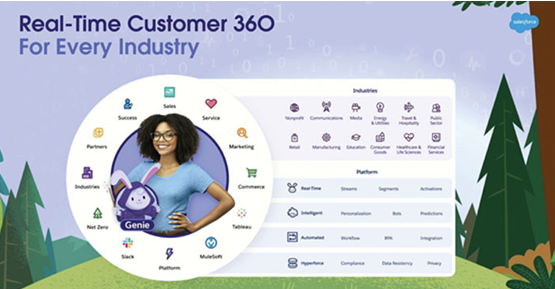This chapter introduces the reader to Salesforce Data Cloud. Readers will be able to understand the value Salesforce Data Cloud brings to the table. They will be able to appreciate how Data Cloud solves the challenges faced by modern CDP tools.
In this chapter, we will explain Salesforce Data Cloud and why Salesforce introduced the product. We will take a look at the challenges resolved by Salesforce Data Cloud that plagues modern customer data platforms. We will talk about the business use cases for it and discuss in theory the concepts important for understanding how Salesforce Data Cloud works. Next, we will understand the high-level workflow of Salesforce Data Cloud. This will help the readers to conceptualize an abstract model of Data Cloud and what it brings to the table. Lastly, we will see how Salesforce Data Cloud fulfills Salesforce’s Customer 360 promise, and understand why Data Cloud plays a crucial role in creating a real-time single source of truth for customer data.
In this chapter, the following topics will be covered:
- Introduction to Salesforce Data Cloud
- Problems solved by Salesforce Data Cloud addition to the Salesforce Ecosystem
- Business use cases for Salesforce Data Cloud
- Key Benefits offered by Salesforce Data Cloud
- Key Concepts for understanding how Salesforce Data Cloud works
- A high-level view of how Salesforce Data Cloud works
- Making Customer 360 Real-time through Salesforce Data Cloud
Introducing Salesforce Data Cloud
In the earlier chapters, we discussed Salesforce and the Customer Data Platform (CDP). We have even briefly discussed Salesforce Data Cloud. So, now is the best time to introduce the main protagonist of our story, The Salesforce Data Cloud, and give it the screen time it deserves. No, we are not writing a screenplay. Nonetheless, Salesforce Data Cloud is the hero of the book, and we have done enough homework to introduce and understand it.

Figure 3.1: Salesforce Data Cloud (Source: https://www.salesforceben.com/salesforce-announce-the-Data-Cloud-platform/)
We want to highlight that Salesforce Data Cloud is also called Data Cloud, Data Cloud Data Cloud, or Customer Data Cloud. All of these refer to the same product. Please do not get confused with the different names. We have used Salesforce Data Cloud or Data Cloud to refer to the product, whereas in different materials you might encounter different names. Nonetheless, it refers to the same product.
Essentially, Salesforce Data Cloud is a CDP with a twist. Hence the title of the book is “Going Beyond CDP: Salesforce Data Cloud”. Salesforce Data Cloud helps to bring all your customer data from different sources in real-time and store it in a central repository to create and activate unified customer profiles.
As we have already discussed in Chapter 1: Introducing the Salesforce platform, to understand Data Cloud, we need to understand another Salesforce product, Salesforce CDP or Data Cloud for Marketing, as it is known now. Salesforce CDP refers to the customer data platform product from Salesforce. Salesforce CDP was created with the initial vision of collecting data from different sources and making it available for marketing for user activations. Data collected from different sources are brought to a central repository and used to power the personalized marketing experience.
However, there was still a gap that needed to be addressed. Even though Salesforce was helping enterprises capture data from different sources and bring it all in one place, the data was not real-time. In today’s fast-paced digital world, data becomes stale very quickly. People check out a product in a retail store and check the price on a mobile app, later they again check on their iPad/tablet and later might make a purchase from their laptop. All of this might happen over a few hours. Companies need to make sure that they provide a consistent experience to users shifting devices or channels. For that, we need data in real-time or near real-time rather than data that is refreshed once a week or even once a day.
Here comes Salesforce Data Cloud. Salesforce Data Cloud was launched to power the customer 360 experience by making data in the Salesforce CDP product available to not just other products of the C360 suite of applications but also to other applications in real-time. The keyword here is real-time. The data to which enterprises will take access will be real-time data. Salesforce Data Cloud powers the Salesforce CDP by making it real-time.
A simplified version looks like this: Salesforce Data Cloud is a real-time customer data platform. In an equation, it would look like:
CDP+Real-time data capabilities= Salesforce Data Cloud

Figure 3.2: Salesforce Data Cloud brings all the customer data to create a unified customer profile
Salesforce Data Cloud provides two innovations:
The first is real-time data. That means it collects and unifies data in milliseconds. Brands can react to customer choices better with real-time customer data.
The second is that it enables all your teams- across sales, service, marketing, commerce, and more-to alter the customer experience in real-time based on the customer’s actions.
Unlike other CDPs on the market, Salesforce Data Cloud is not solely focused on marketing or commerce. It goes beyond that. Salesforce Data Cloud brings data from all the customer interactions with the brand. Customers feel the difference when they don’t need to repeatedly tell the different customer service reps what they bought, what issues they face, and what resolution they want. We all have faced this frustration when we had to tell the different customer service reps our problems time and again as they don’t have the information we provided yesterday to a different agent. Salesforce Data Cloud aims to solve this and other such problems for customers.
